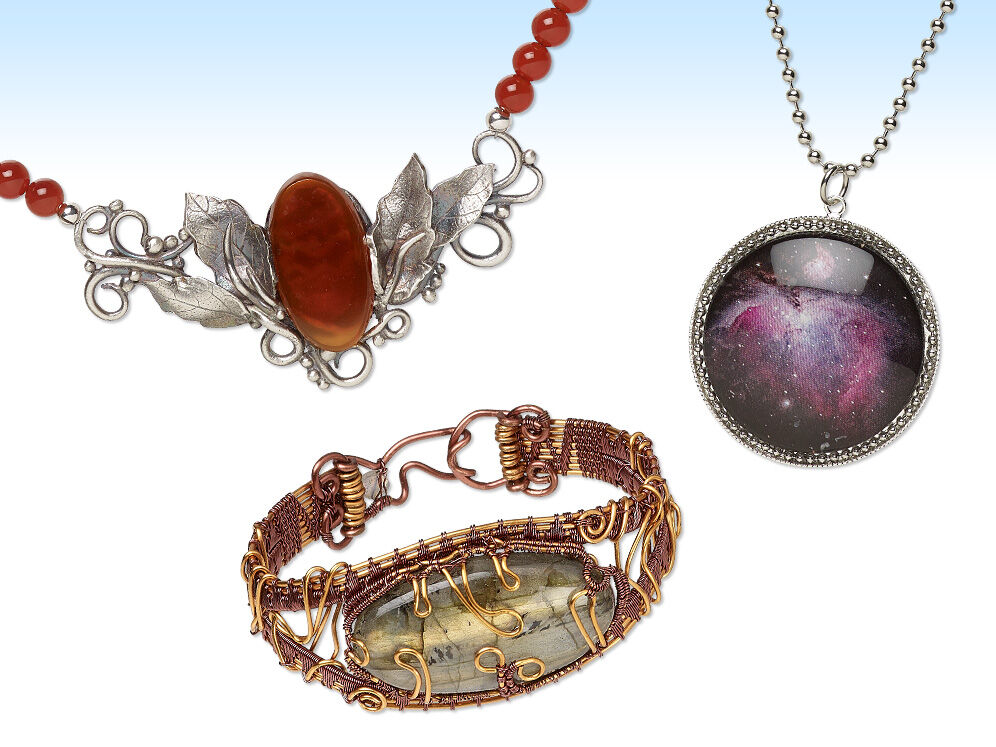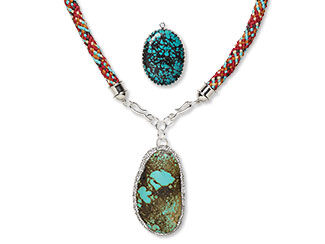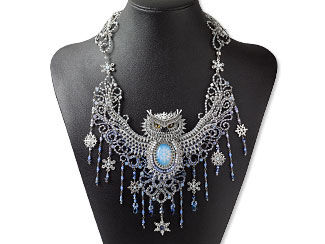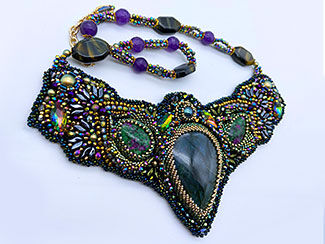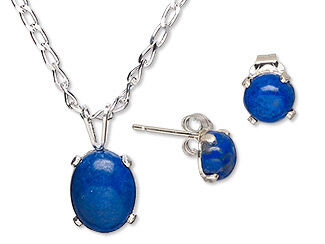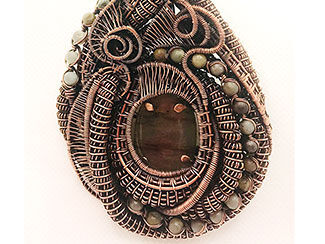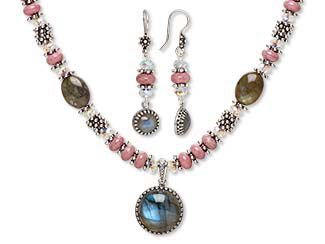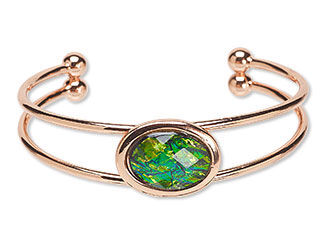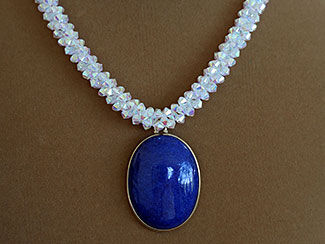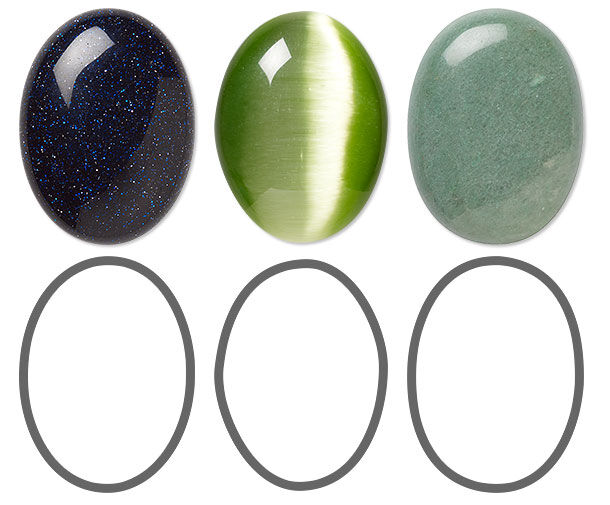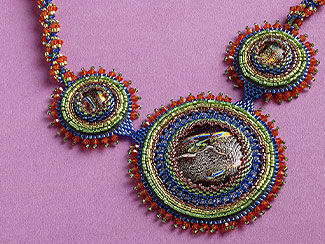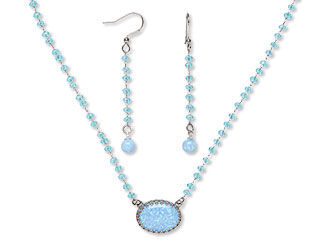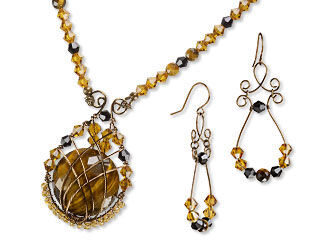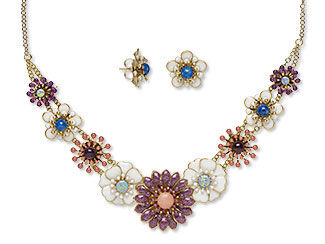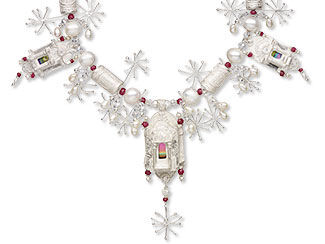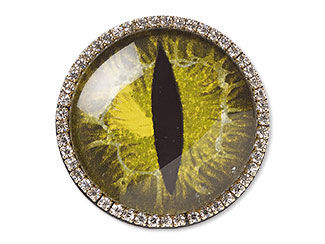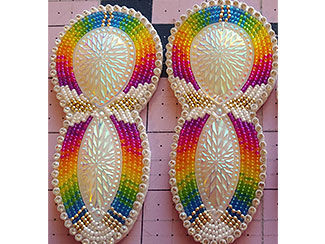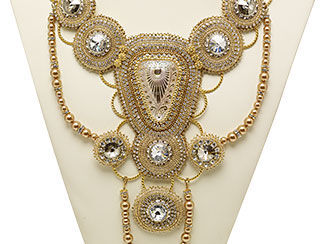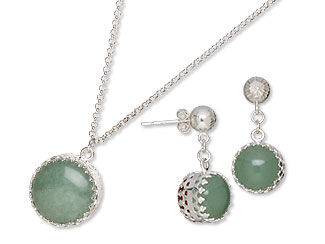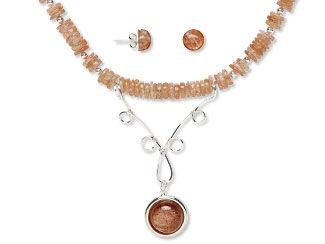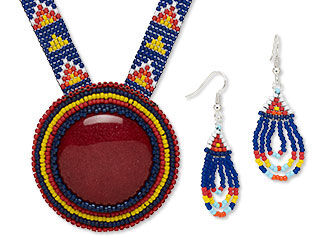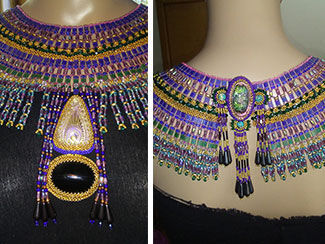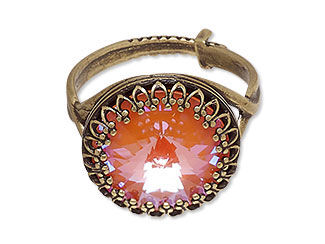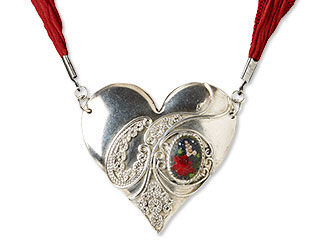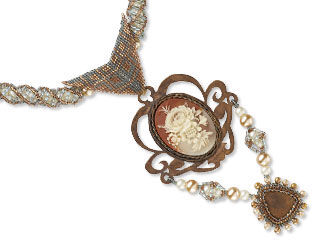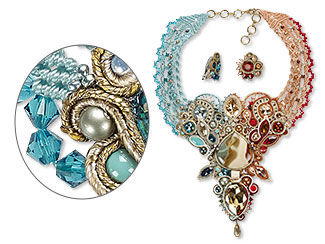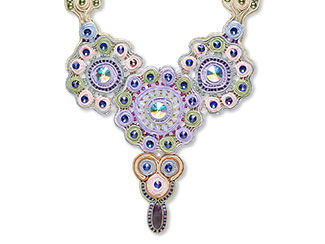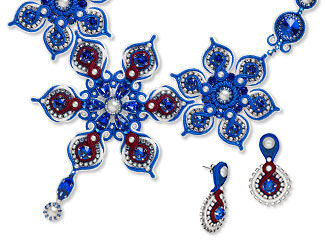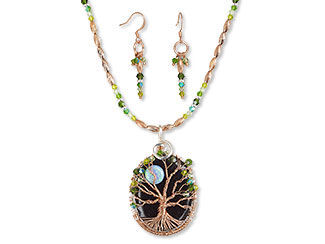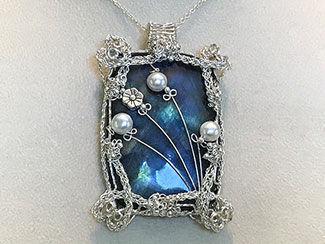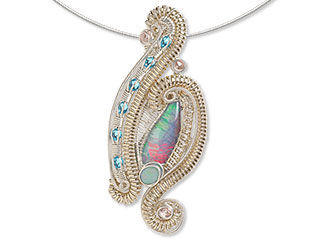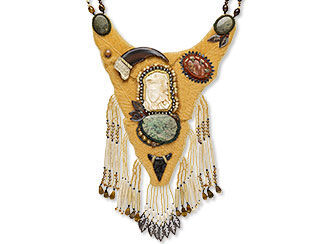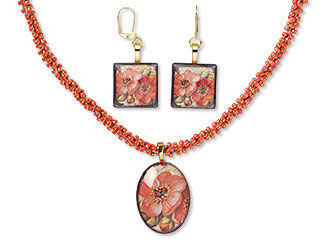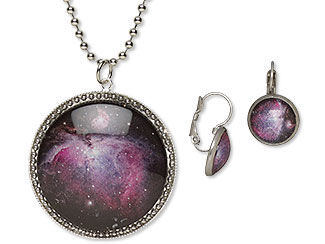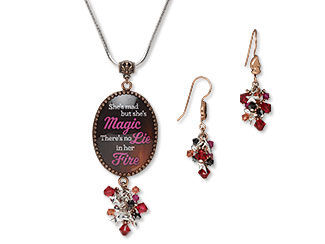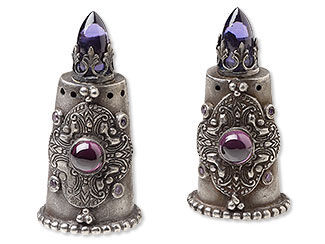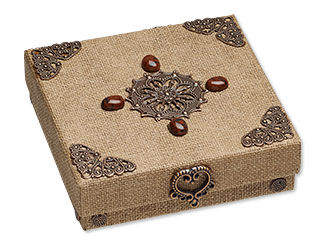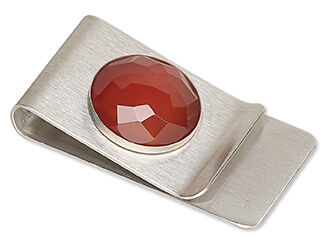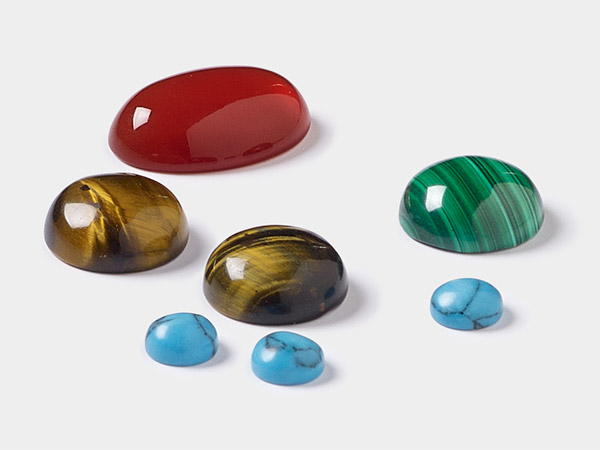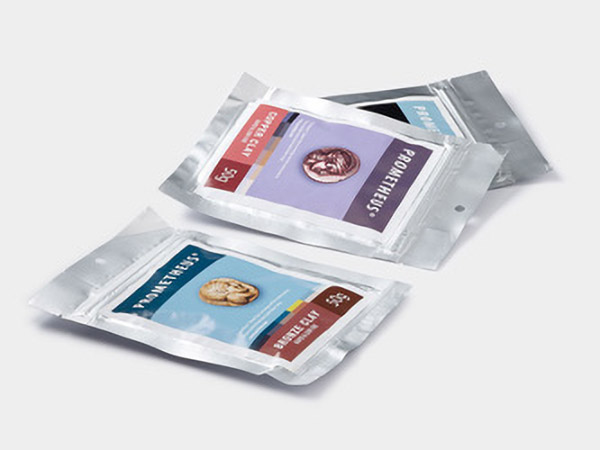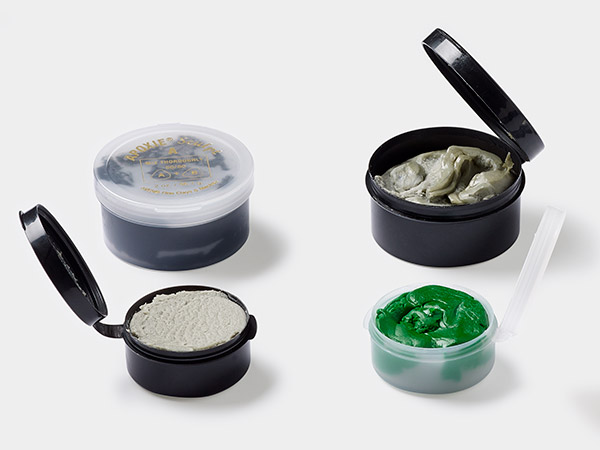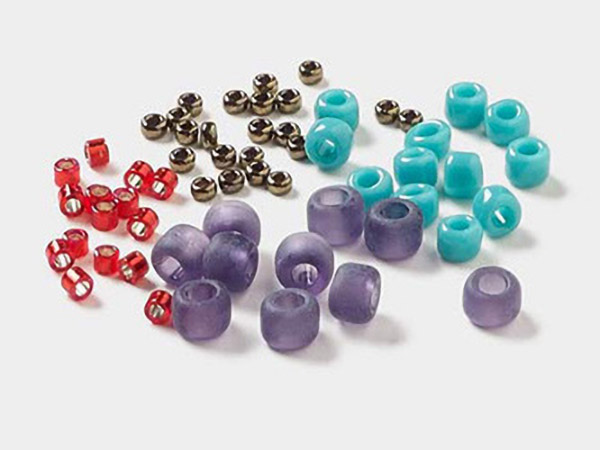What Is a Cabochon? How this Jewelry Component is Made and Used
by Tiffany Conley, Design Idea K12N; by Karen Suarez, Design Idea G228; Design Idea L54U
The term cabochon (KAB-oh-shon) refers to a piece of gemstone (or other material) which has been shaped and polished, instead of faceted. Such stones have a domed front surface and a flat back.
The process of creating this shape is called cutting en cabochon, and is usually applied to softer gemstone materials, opaque gemstones and stones which display special effects such as asterism (displaying a star across the surface), chatoyancy (sha-TOY-en-see—a cat's eye effect) and iridescence (a play of colors within the stone). Popular materials to cut en cabochon include star ruby and sapphire, amber, malachite, opal, tigereye, labradorite, Oregon sunstone, rainbow moonstone and turquoise. The most common shape is an oval or ellipse, although other geometric and freeform shapes are also cut.
View the Cabochon Size and Shape Chart for a range of common options.
How to Cut Cabochons
Cabochons are usually cut from a slice of gemstone rough or other materials using a calibrated stencil template, or in freeform shapes for customized manufacturing. Due to labor costs, cabochon making frequently begins on a cam-cutter, a machine that completes 75% of the cutting process. Individual cabochons are then ground into shape with grinding disks or belts coated with silicon carbide or diamond dust. Cutting cabochons can be an expensive interest to get started with, even on a hobbyist level. It's how Stuart got started in the business, so we can say that from experience!
Cabochon stones (often shortened to "cabs" in the jewelry-making world) are shaped using a handcrafting technique called dopping (pronunciation: DAHP-ping). Dopping involves adhering the cab to a dowel or rod with a hard wax, creating the curved or beveled edges, then sanding and polishing the top into a uniform dome. As most of this work is done by hand, the height and curve of the dome varies, which can affect how the cabochon fits in standardized settings.
Cabochons are calibrated to match popular or frequently used standardized setting sizes such as 20mm round or 40x30mm oval. Calibration refers only to this size-and-shape indicator. Cabochon qualities such as gemstone grades, polishes, finishes, beveled edges or carved surfaces are not affected by whether a cabochon is considered calibrated or uncalibrated.
Calibrated cabochons can still vary greatly, even if they fit the measurement and shape guidelines. Cabochons are measured by their largest points: side to side and end to end. The arc or curve between those compass points can be shallow or deep, resulting in cabochons which are calibrated yet not identical in shape. Oval cabochons are the most variable, as they can vary between a narrow curve close to a marquise to a wide curve similar to a rounded rectangle.
Cabochons are rarely identical because of dopping and the range of Mohs hardnesses in cabochon materials make some stones difficult to cut and polish—plus wear-and-tear on lapidary machinery changes how stones in the same batch come out. These factors contribute to varying calibrations from cabochon to cabochon.
Glass cabochons such as goldstone, cat’s eye (fiber optic) glass, dichroic glass and imitation pearl-coated crystal—as well as plastic cabs and cameos—are usually molded into their shapes rather than shaped with dopping. Before baking into metal or polymer clays, please review the temperatures these materials can handle.
Using Cabochons
Since they don't have a drill hole, cabochons can appear to be a challenge to use. These flat-backed beauties, however, can easily be added to jewelry and accessories. Jewelry makers can use them as focals, eyes in jewelry and décor, accents on clothing and much more. Cabochons can be used in calibrated settings, designer-created bezel settings and other artistic techniques.

Patti, a jewelry designer here at Fire Mountain Gems and Beads, shares some great ways to use cabochons in your jewelry projects.
This is where calibrated cabochon mountings and settings come in—including Cab-Tite™, Wrap-Tite®, Bezellite, cinch mount and Almost Instant Jewelry® settings—as well as most solid-back and open-back bezel cups, prong-set and glue-in settings. Settings include pendants, drops, links, rings, bracelets and a variety of earring findings.
There are reasons that cabochons can be hard to fit into calibrated settings, however. As the arc or curve of a cabochon's shape—as well as the height of its dome—can vary, jewelry designers may need to take extra care when selecting settings or mountings. Settings made of more rigid metals such as brass and pewter may not fit all cabochons, even if both mounting and cabochon match in millimeter sizes. This is especially true of oval settings, as the curve of the oval in the setting and cabochon may not be identical, as you can see below. Each cabochon is an oval measuring 40x30mm, yet jewelry makers can see the subtle difference in each cabochon when compared to others. Some ovals are much closer to a marquise shape than others, so a custom setting may be in order.
Custom metal settings can be created for uncalibrated or freeform cabochons using bezel strips and metal sheet, or a range of metal clays: Art Clay® Silver and 22Kt gold plus copper, bronze, fine silver and sterling silver from Prometheus®. Designer-artists can also showcase non-calibrated cabochons in standard shapes—oval, round, marquise, teardrop and others—as well as freeform cabochons using the techniques below.
Custom Settings
While premade settings are a lovely and easy way to display cabochons, for truly one-of-a-kind designs, consider making your own settings out of a range of jewelry-making materials. Find inspiration and widen the spectrum of what cabs can do. You'll never have to worry about a cabochon fitting into a premade setting again.
Clays and Resins
Polymer clays, metal clays and air-dry resins such as Vitrium® and Apoxie® Sculpt offer a whole world of opportunities. Mold your preferred compound on and around cabochons then bake or fire—it's that easy with the proper tools. It is important to make sure the cabochons chosen will withstand the type of heat source being used. Gemstone cabochons stand up well to the lower temperatures of polymer clay baking, except for opal and amber. Glass cabochons are also a safe bet. Plastic and similar materials might melt or scorch, so use air-dry resins for them. Metal clays require a much higher temperature range and it's important to determine which stones can be safely used; refer to the ''Firing Gemstones and Natural Stones in Art Clay®'' chart for guidelines for Art Clay®, and "Prometheus® Metal Clays Firing Methods" chart for guidelines for Prometheus® Clay.
Note: When using metal clays, reference packaging for shrinkage rate to accommodate for size changes that occur during firing.
Cupchain
Make a sparkly frame for cabochons with cupchain available in multiple metal tones and glass colors to match or contrast with cabochons. Use a sturdy backing such as Lacy's Stiff Stuff™, leather or metal sheet, and high-strength glue or Apoxie® Sculpt to set the cabochon and cupchain. This border is fun to mix with seed bead embroidery and soutache.
Glues and Adhesives
One of the easiest ways to use cabochons—especially freeform shapes—is to adhere them to findings with flat surfaces such as glue-on bails, earrings with flat pads, ring bases and bracelet bases.
Seed Beads
The small but mighty seed bead is one of the most popular ways to secure cabochons in jewelry. Embroider seed beads across the top or around the edge of cabs in any desired shape to keep them in place. Bead embroidery designer Jody Young is known worldwide for this type of technique and offers expert advice in her Unlock Your Heart video series.
Solder
Consider a hot way to use cabochons: soldering a ready-made or custom-built bezel directly around the outside of a cab to create a perfect and custom fit. A stellar example is the planetary pendant created by renowned jewelry-making expert Tammy Honaman. Complete instructions explain how this technique works, providing you with the tool knowledge and inspiration to solder cabochons into your own designs. All you need are soldering tools.
Soutache and Other Cord
Using soutache or other flat cording to capture beads and stones is an active trend in jewelry design. Straight off the fashion runways, soutache is a combination of sewing and beading that stands out as an elegant way to display your favorite cabochons.
Wire-Wrapping
Curl, twist, bend, coil and otherwise have fun playing with wire to surround cabochons. This technique requires no backing and the result is as intricate or stylishly simple as you create. While any shape is suitable, square wire is often used for the main frame since it lies flush against other wire and makes a solid surface for cabochons to rest against. Half-round wire is recommended for wrapping around the main wire frame to stabilize construction. Oval cabochons can be easily wrapped using the Bead Buddy® Cabochon Mandrel, while round or freeform shapes may need a custom cabochon setting.
Make sure the frame is complete before adding any embellishment or decoration. An expert tip from in-house jewelry maker Rose is to use painter's tape while wrapping to keep everything together without leaving any kind of sticky residue. The preferred size tends to be 20 gauge. Mix and match size, shape and even color to display cabochons in all their splendor.
Other Uses
Now that you have a plethora of ways to display cabs, try techniques to alter or capitalize on cabochon types for unique designs.
Carve
Depending on the material type, the surface of cabochons can be carved, etched and scrimshawed. Bone is a common material used to scrimshaw since it has a Mohs hardness of 2-1/2. Usually a stone with Mohs hardness of 6 or below is able to be carved. The harder the stone, the harder it is to scratch the surface and instead of shaving off pieces, stones run the risk of cracking. Use rotary hand tools and steel cutting burs to shape and carve cabochon surfaces. Cameos made from natural materials such as shell are one example of carving. Bone and shell are also great materials for dyes, so coloring before or after carving offers even more interesting effects. Learn how to dye bone in the article ''Dyed Bone Components and Beads''.
Glass Cabs
Clear glass cabochons magnify images placed underneath. Put any image or vintage photograph beneath glass cabs for a timeless look or create a mythical-looking eye staring out at the world. Gemstones such as onyx also work well for eyes. This is also a popular way to customize cuff links for personalized men's accessories or a coordinated wedding party.
Not Just Jewelry
Use any number of described techniques to incorporate cabochons as eye-catching additions to accessories, footwear, clothing, costumes or home décor. Make a cabochon the focal point of beading on a purse, add cabochon accents to belts and headwear or decorate clothing with the shine of polished cabs.
Shop for Your Materials Here:
Have a question regarding this project? Email Customer Service.
Copyright Permissions
All works of authorship (articles, videos, tutorials and other creative works) are from the Fire Mountain Gems and Beads® Collection, and permission to copy is granted for non-commercial educational purposes only. All other reproduction requires written permission. For more information, please email copyrightpermission@firemtn.com.
